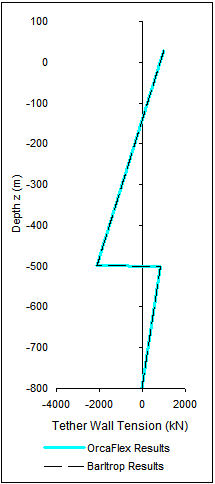Orcina have recently carried out a validation of the way OrcaFlex handles buoyancy forces and pipe internal contents pressure effects, and the resulting effective tension and wall tension that OrcaFlex reports. We have validated these OrcaFlex results against results presented in Nigel Barltrop’s well-respected book “Dynamics of Floating Structures: a guide for design and analysis. Volume 2”. The OrcaFlex results matched the Barltrop results very well, confirming that OrcaFlex models buoyancy and internal pressure effects correctly.
Section 11B of Barltrop’s book (see page 11-56) contains a useful explanation of the concept of effective tension and the modelling of buoyancy and contents pressure forces. It also gives two illustrative worked examples for vertical lines: one a tether with a change in cross section part way down and one a riser with contents pressure. We have modelled these two examples in OrcaFlex and the results matched Barltrop’s results very well.
For the tether example the following graphs show the OrcaFlex wall tension and effective tension results, with the Barltrop results overlaid as a dashed black line. The results match very well, and the results for the riser example also matched the Barltrop results very well. This confirms that OrcaFlex models buoyancy and internal pressure effects correctly. For full details see validation case 99/107 from the OrcaFlex validation page of our website.

